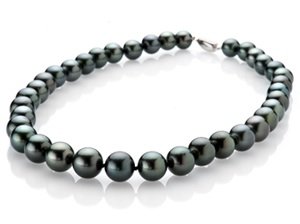The truth about pearls
The truth about pearls
There is more to strings of Pearls than meets the eye and as objects of beauty they always captivate. One may be aware that Pearls originate from Molluscs, but how they form is a fascinating story.
Pearls come into being when a foreign body such as a grain of sand find its way into an Oyster or a Freshwater Mussel shell, which in self-defence surrounds the intruder with a cyst. An Oyster then deposits numerous thin concentric layers of Pearl (Nacre) and Conchiolin, an organic substance similar to horn, until the intruder has been completely encapsulated. The Freshwater Mussel’s process is slightly different, resulting in a more homogenous structure without a central nucleus.
 The colour of a Pearl is determined by the inside of the mollusc shell, and what the creature in question has been eating. Most Pearls are white with a touch of pink, grey, yellow sometimes blackish, or iridescent from green/blue/violet to mauve. Great importance is attached to the homogeneity of Pearls and they are also evaluated according to size, colour, lustre, regularity of form and compactness. A thick layer of Nacre is more lustrous and durable and so more valuable.
The colour of a Pearl is determined by the inside of the mollusc shell, and what the creature in question has been eating. Most Pearls are white with a touch of pink, grey, yellow sometimes blackish, or iridescent from green/blue/violet to mauve. Great importance is attached to the homogeneity of Pearls and they are also evaluated according to size, colour, lustre, regularity of form and compactness. A thick layer of Nacre is more lustrous and durable and so more valuable.
Few natural Pearls are harvested today, as Cultured Pearls are grown so successfully especially in Japan where their production was pioneered at the start of the 20th Century. To create a Cultured Pearl, a Mother-of-Pearl bead is wrapped in a small piece of tissue from one Oyster, which is then inserted into another live Oyster. This Oyster is then suspended in a basket from rafts with other Oysters in calm and clean well-oxygenated seawater, at a depth and temperature conducive to optimal growth. After several years the Pearls are harvested. The best and more expensive Pearls are grown at greater depths more slowly and harvested after several more years.
 As Pearls consist of an organic substance they will age – if they become dehydrated they will dull, then crack and finally peel. There is no definite length of life for a Pearl and some natural Pearls are known to be several hundred years old (indeed Elizabethan Pearls are inset into one of our Queen’s crowns).
As Pearls consist of an organic substance they will age – if they become dehydrated they will dull, then crack and finally peel. There is no definite length of life for a Pearl and some natural Pearls are known to be several hundred years old (indeed Elizabethan Pearls are inset into one of our Queen’s crowns).
Care can help to preserve Pearls; dryness as well as humidity are detrimental and they are also sensitive to acids, perspiration, cosmetics, perfume and hairspray. It is a golden rule to always put on your Pearls last of all.
When the Silk on which Pearls are strung becomes grey and dirty it is essential to have them restrung by a professional. Bacteria colonising the silk respire, producing Carbon Dioxide which is acidic (as per acid rain) and it will destroy the Pearl quickly around the drill hole. It is also important to have Pearls strung with knots to separate them and prevent them rubbing, which causes chipping and scratching, as they are relatively soft.
Heidi will personally restring your Pearls to help preserve their life, always using double knots to minimise the loss of Pearls in the event of the silk breaking.
Please feel free to call into my Mill Street shop to see Cultured Pearls of all types. My favourites are the lustrous Akoya and the most highly sought after South Sea and Tahitian Pearls. I make all of our Pearl necklaces and matching earrings, so you can specify the size and quality of your choice.
